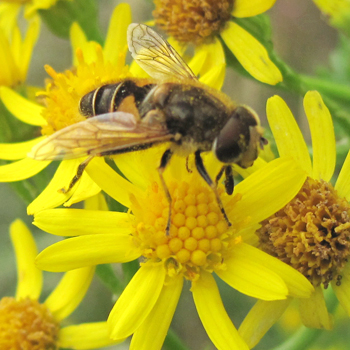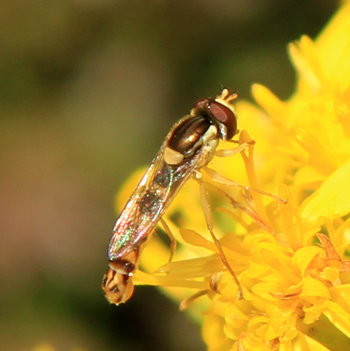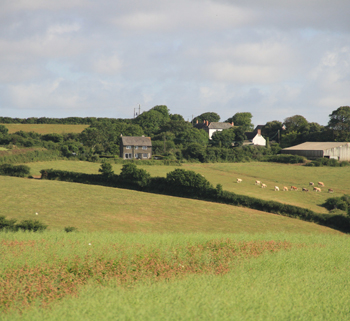 Hoverflies: often brightly marked, sometimes almost waspish and therefore slightly scary, are everywhere, settling on pollen-rich flora among the bees and butterflies. Their role as pollinators is as vital as the bees and butterflies.
Hoverflies: often brightly marked, sometimes almost waspish and therefore slightly scary, are everywhere, settling on pollen-rich flora among the bees and butterflies. Their role as pollinators is as vital as the bees and butterflies.
Despite appearances hoverflies are, as the name implies, simply that: flies. They are members of the family Syrphidae in the order Diptera, the true flies, having one pair of wings. By contrast, wasps and bees have two pairs of wings. There are around 270 species of hoverfly in the UK, many of which are present here in the Roseland as elsewhere. Commonly, they are brightly patterned and coloured, mimicking the morphological characteristics of wasps and bees in order to avoid predation. The most easily recognised hoverfly is Episyrphus balteatus, the ‘marmalade fly’, with its thin but rather waspish patterning and colouring (see right).
 However, when not seen landing on flora to feed on nectar and pollen, the darting flight and hovering behaviours evince the difference between hoverflies and other insects. They can fly in bursts of up to 40km/h, making them difficult to follow with the naked eye. Here’s a great slow-motion video of hoverflies in flight on youtube.
However, when not seen landing on flora to feed on nectar and pollen, the darting flight and hovering behaviours evince the difference between hoverflies and other insects. They can fly in bursts of up to 40km/h, making them difficult to follow with the naked eye. Here’s a great slow-motion video of hoverflies in flight on youtube.
Hoverflies live in diverse habitats, many of which are threatened. Land management plays an important role in providing, reducing or removing the optimal resources required for these important pollinators to thrive. Bog and marsh habitats, for example, provide the flora important to bog specialists. Some species are saproxylic, their breeding ecology requiring the presence of decaying wood, so leaving piles of logs and old tree stumps in place will benefit them. Others are dependent on the presence of host species such as aphids or ants. Many of our common hoverflies are present in gardens and in the agricultural landscape.
 Adult hoverflies feed principally on nectar and pollen, available from early spring through to late autumn. Nectar and pollen are also nutritionally important for mature the female hoverfly’s eggs. The emerging larvae are voracious predators, consuming aphids and many other garden and agricultural pests. Being active during the daytime, their importance in evaluating habitat ecology is usefully and easily assessed. So the importance of hoverflies to us humans cannot be too heavily underlined.
Adult hoverflies feed principally on nectar and pollen, available from early spring through to late autumn. Nectar and pollen are also nutritionally important for mature the female hoverfly’s eggs. The emerging larvae are voracious predators, consuming aphids and many other garden and agricultural pests. Being active during the daytime, their importance in evaluating habitat ecology is usefully and easily assessed. So the importance of hoverflies to us humans cannot be too heavily underlined.
Here’s a great basic startup guide to identifying hoverflies.
Cirl Bunting Reintroduction Project News
Some sad news to report this issue, though not directly about the Cirls themselves. One of our long-term project volunteers, Sid Cole, passed away in August, after an all too late diagnosis of untreatable cancer. He was 77 years old. Just weeks before he died, he had been out in the field with us, shouldering his heavy scope and tripod, helping us look for specific pairs of cirls and reporting on their breeding activity and behaviours. Sid’s knowledge and expertise in small passerine behaviour made a hugely important contribution in helping the RSPB to build a finely tuned understanding of the breeding and feeding ecology of the Roseland cirls.  Without Sid’s expert and minute observations, we would have missed so much. Sid lived in St Austell, and he loved his regular visits to the Roseland, his favourite spot of all being Lanhay with its magical views out over St Just and Polingey creeks. We hope to set up a fitting memorial to him there in the near future.
Without Sid’s expert and minute observations, we would have missed so much. Sid lived in St Austell, and he loved his regular visits to the Roseland, his favourite spot of all being Lanhay with its magical views out over St Just and Polingey creeks. We hope to set up a fitting memorial to him there in the near future.
The RSPB places huge importance and value on volunteers like Sid. Without them, so much of the vital conservation work that we do could simply not be achieved. Even the small things, like putting out seed regularly to support the growing population of cirls, can make the difference between project success and failure, especially when conditions become challenging – long spells of bad weather, for instance. The Roseland Cirl bunting Reintroduction Project has now been ‘officially’ recorded as a success, because the number of breeding pairs has remained well above 30 for the last two years. So the project is now going into a maintenance stage. We will continue to provide seed supplementation and monitor the population level for a number of years to come. This will still rely heavily on the help of volunteers, so if any readers are interested in helping with this work, then do get in touch.
Things to do this month in the garden
- If you don’t already have one, consider creating a pile of old logs in a corner of your garden for the larvae of pollinating insects, such as hoverflies, to inhabit. It does not need to be very big or obvious. Allowing ivy to grow over it can be attractive and help to retain moisture in the pile, helping the wood to rot down more.
- Now that a lot of natural food is available out in the fields and countryside, many birds are not visiting garden feed points for food. They may also be hiding away whilst undergoing the autumn moult. So clean out your bird feeders thoroughly to kill of any harmful bugs and bacteria. Hot water and general washing up liquid will suffice; rinse thoroughly to get rid of any soapy residue. Remember to give yur feeders a general clean once a week as the season progresses into colder, wetter weather.
References
Stubbs, AE & Falk, SJ (2012) British Hoverflies: An Illustrated Identification. ISBN : 9781899935055
Natureguide UK (2015) Hoverflies. Online article. Available from: https://sites.google.com/site/natureguideuk/home/hoverflies
British Hoverflies: Online article. Available from: http://syrphidae.3644.co.uk/
All Photography by Sarah E Vandome, unless otherwise indicated.
Enjoy more Roseland wildlife and landscapes – visit my Heart of Roseland Facebook feature: https://www.facebook.com/HeartOfRoseland?ref=hl

